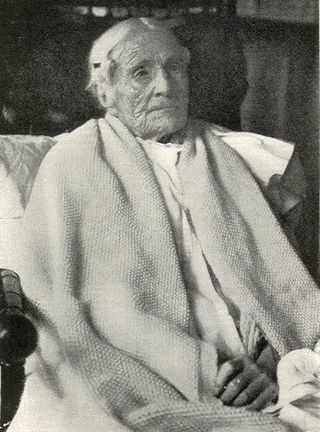Related Research Articles

Life expectancy is a statistical measure of the estimate of the span of a life. The most commonly used measure is life expectancy at birth (LEB), which can be defined in two ways. Cohort LEB is the mean length of life of a birth cohort and can be computed only for cohorts born so long ago that all their members have died. Period LEB is the mean length of life of a hypothetical cohort assumed to be exposed, from birth through death, to the mortality rates observed at a given year. National LEB figures reported by national agencies and international organizations for human populations are estimates of period LEB.
Psychophysiology is the branch of psychology that is concerned with the physiological bases of psychological processes. While psychophysiology was a general broad field of research in the 1960s and 1970s, it has now become quite specialized, based on methods, topic of studies and scientific traditions. Methods vary as combinations of electrophysiological methods, neuroimaging, and neurochemistry. Topics have branched into subspecializations such as social, sport, cognitive, cardiovascular, clinical and other branches of psychophysiology.

Senescence or biological aging is the gradual deterioration of functional characteristics in living organisms. The word senescence can refer to either cellular senescence or to senescence of the whole organism. Organismal senescence involves an increase in death rates and/or a decrease in fecundity with increasing age, at least in the latter part of an organism's life cycle.

A population pyramid or "age-sex pyramid" is a graphical illustration of the distribution of a population by age groups and sex; it typically takes the shape of a pyramid when the population is growing. Males are usually shown on the left and females on the right, and they may be measured in absolute numbers or as a percentage of the total population. The pyramid can be used to visualize the age of a particular population. It is also used in ecology to determine the overall age distribution of a population; an indication of the reproductive capabilities and likelihood of the continuation of a species. Number of people per unit area of land is called population density.

In actuarial science and demography, a life table is a table which shows, for each age, what the probability is that a person of that age will die before their next birthday. In other words, it represents the survivorship of people from a certain population. They can also be explained as a long-term mathematical way to measure a population's longevity. Tables have been created by demographers including John Graunt, Reed and Merrell, Keyfitz, and Greville.
Nominative determinism is the hypothesis that people tend to gravitate towards areas of work that fit their names. The term was first used in the magazine New Scientist in 1994, after the magazine's humorous "Feedback" column noted several studies carried out by researchers with remarkably fitting surnames. These included a book on polar explorations by Daniel Snowman and an article on urology by researchers named Splatt and Weedon. These and other examples led to light-hearted speculation that some sort of psychological effect was at work. Since the term appeared, nominative determinism has been an irregularly recurring topic in New Scientist, as readers continue to submit examples. Nominative determinism differs from the related concept aptronym, and its synonyms 'aptonym', 'namephreak', and 'Perfect Fit Last Name', in that it focuses on causality. 'Aptronym' merely means the name is fitting, without saying anything about why it has come to fit.
The Baskerville effect, or the Hound of the Baskervilles effect, is the alleged self-fulfilling prophecy that there is an increase in rate of mortality through heart attacks on days considered unlucky because of the psychological stress this causes on superstitious people. The term derives from the Sherlock Holmes novel The Hound of the Baskervilles in which a hellish-looking dog chases Sir Charles Baskerville, sufferer of a chronic heart disease. According to legend, the dog cursed his family, Baskerville runs in great fear and dies of a heart attack "with an expression of horror in his face".

In demography and medical geography, epidemiological transition is a theory which "describes changing population patterns in terms of fertility, life expectancy, mortality, and leading causes of death." For example, a phase of development marked by a sudden increase in population growth rates brought by improved food security and innovations in public health and medicine, can be followed by a re-leveling of population growth due to subsequent declines in fertility rates. Such a transition can account for the replacement of infectious diseases by chronic diseases over time due to increased life span as a result of improved health care and disease prevention. This theory was originally posited by Abdel Omran in 1971.

The Hispanic paradox is an epidemiological finding that Hispanic Americans tend to have health outcomes that "paradoxically" are comparable to, or in some cases better than, those of their U.S. non-Hispanic White counterparts, even though Hispanics have lower average income and education. Low socioeconomic status is almost universally associated with worse population health and higher death rates everywhere in the world. The paradox usually refers in particular to low mortality among Hispanics in the United States relative to non-Hispanic Whites. According to the Center for Disease Control's 2015 Vital Signs report, Hispanics in the United States had a 24% lower risk of mortality, as well as lower risk for nine of the fifteen leading causes of death as compared to Whites.
Nicholas Christenfeld is a former professor of Psychology at the University of California, San Diego until his dismissal in 2019. He first joined the department in 1991 and was a full professor from 2003 to 2019. Among other research, he has promulgated the Theory of Deadly Initials and the theory that infants resemble their fathers more closely than they do their mothers. More recently, he studied the tendency of people to choose purebred dogs which resembled them.
Divorce affects the couple’s children in both the short and the long term. After divorce, the couple often experiences effects including, decreased levels of happiness, change in economic status, and emotional problems. The effects on children include academic, behavioral, and psychological problems. Studies suggest that children from divorced families are more likely to exhibit such behavioral issues than those from non-divorced families.
Tend-and-befriend is a behavior exhibited by some animals, including humans, in response to threat. It refers to protection of offspring (tending) and seeking out their social group for mutual defense (befriending). In evolutionary psychology, tend-and-befriend is theorized as having evolved as the typical female response to stress.
Type D personality, a concept used in the field of medical psychology, is defined as the joint tendency towards negative affectivity and social inhibition. The letter D stands for "distressed".
The name-letter effect is the tendency of people to prefer the letters in their name over other letters in the alphabet. Whether subjects are asked to rank all letters of the alphabet, rate each of the letters, choose the letter they prefer out of a set of two, or pick a small set of letters they most prefer, on average people consistently like the letters in their own name the most. Crucially, subjects are not aware that they are choosing letters from their name.
Social epidemiology focuses on the patterns in morbidity and mortality rates that emerge as a result of social characteristics. While an individual's lifestyle choices or family history may place him or her at an increased risk for developing certain illnesses, there are social inequalities in health that cannot be explained by individual factors. Variations in health outcomes in the United States are attributed to several social characteristics, such as gender, race, socioeconomic status, the environment, and educational attainment. Inequalities in any or all of these social categories can contribute to health disparities, with some groups placed at an increased risk for acquiring chronic diseases than others.
Scholarly studies have investigated the effects of religion on health. The World Health Organization (WHO) discerns four dimensions of health, namely physical, social, mental, and spiritual health. Having a religious belief may have both positive and negative impacts on health and morbidity.

The Glasgow effect refers to the lower life expectancy of residents of Glasgow compared to the rest of the United Kingdom and Europe. The phenomenon is defined as an "[e]xcess mortality in the West of Scotland (Glasgow) after controlling for deprivation." Although lower income levels are generally associated with poor health and a shorter lifespan, epidemiologists have argued that poverty alone does not appear to account for the disparity found in Glasgow. Equally deprived areas of the UK such as Liverpool and Manchester have higher life expectancies, and the wealthiest ten percent of the Glasgow population have a lower life expectancy than the same group in other cities. One in four men in Glasgow will die before his sixty-fifth birthday.
Gary Nance Smith is the Fletcher Jones Professor of Economics at Pomona College. His research on financial markets statistical reasoning, and artificial intelligence, often involves stock market anomalies, statistical fallacies, and the misuse of data have been widely cited.
The weathering hypothesis was proposed to account for early health deterioration as a result of cumulative exposure to experiences of social, economic and political adversity. It is well documented that minority groups and marginalized communities suffer from poorer health outcomes. This may be due to a multitude of stressors including prejudice, social alienation, institutional bias, political oppression, economic exclusion and racial discrimination. The weathering hypothesis proposes that the cumulative burden of these stressors as individuals age is "weathering," and the increased weathering experienced by minority groups compared to others can account for differences in health outcomes. In recent years, the biological plausibility of the weathering hypothesis has been investigated in studies evaluating the physiological effects of social, environmental and political stressors among marginalized communities. This has led to more widespread use of the weathering hypothesis as a framework for explaining health disparities on the basis of differential exposure to racially based stressors. Researchers have also identified patterns connecting weathering to biological phenomena associated with stress and aging, such as allostatic load, epigenetics, telomere shortening, and accelerated brain aging.
White Americans, as the largest racial group in the United States, have historically had better health outcomes than other oppressed racial groups in America. However, in recent years, the scholarly discourse has switched from recognition of the immense positive health outcomes of white Americans towards understanding the growing persistence of negative outcomes unique to this racial group. Scholars have discussed the effects of racial prejudice and its negative effect on health outcomes to not only those being oppressed but also those being given privileges. In addition to the effects of living in a racialized society, white Americans have the highest rate of suicide and lifetime psychiatric disorders of any other ethnicity or racial category. In conjunction with these psychiatric issues, the population presents higher rates of alcohol usage alongside lower levels of psychological flourishing. Given this information, the health status of white Americans has gained increasing importance due to the differences in health outcomes between white Americans and white people from other parts of the world.
References
- ↑ What's in a name: Mortality and the power of symbol. Christenfeld, Nicholas, David P. Phillips and Laura M. Glynn. J. Psychosomatic Research, vol. 47 no. 3 (September 1999), pp. 241–254.
- ↑ Monogrammic Determinism?. Smith, Gary and Stilian Morrison. Psychosomatic Medicine, no. 67 (2005) pp. 820–824.
- ↑ Abrahams, Marc (March 27, 2006). "What's in a name". The Guardian.